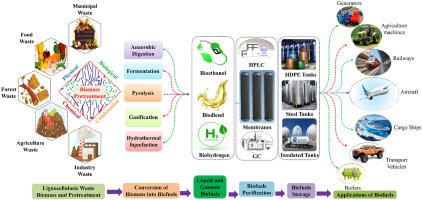Recent developments in separation and storage of lignocellulosic biomass-derived liquid and gaseous biofuels: A comprehensive review
IF 5.8
2区 生物学
Q1 AGRICULTURAL ENGINEERING
引用次数: 0
Abstract
The global availability of nearly 200 billion tonnes of lignocellulosic biomass has intensified the pursuit of advanced separation, purification, and storage technologies to enhance the quality, yield, and accessibility of sustainable biofuels. The complex composition of biomass hydrolysates, the presence of inhibitory byproducts, and the energy-intensive nature of separation and storage often contributing 40–70 % of total production costs present major challenges for the efficient separation and storage of biomass-derived liquid and gaseous biofuels. Novel approaches to liquid biofuel purification, such as advanced distillation (extractive, azeotropic), membrane separation (nanofiltration, pervaporation), and adsorption (molecular sieves, activated carbon), have shown promise whereas integrated membrane-distillation systems, further, reduce energy consumption by up to 57 % while achieving & > 99.5 % purity in ethanol and butanol. In bioethanol, biobutanol, liquid-liquid extraction, and gas stripping have gained popularity, while pyrolysis oil fractional condensation is used to separate valuable fractions. Advancements in gaseous biofuel purification include pressure swing adsorption for biogas upgrading and membrane technologies for CO2 and H2S removal. Emerging technologies like ionic liquids and deep eutectic solvents offer potential for energy-efficient, selective separation, while cryogenic storage at −253 °C and pressures up to 700 bar, along with hybrid storage systems, further improve the safety and stability of gaseous fuels. Process intensification through modular and integrated systems, combined with the use of (Artificial Intelligence) AI for optimization, is reshaping purification workflows. Sustainability assessments highlight the importance of striking a balance between efficiency and environmental impact. This review emphasizes the importance of separation and storage in enabling the commercial viability of lignocellulosic biofuels, as well as providing insights for developing renewable energy systems.

木质纤维素生物质衍生的液体和气体生物燃料的分离和储存的最新进展:综合综述
全球近2000亿吨的木质纤维素生物质的可用性,加强了对先进分离、净化和储存技术的追求,以提高可持续生物燃料的质量、产量和可及性。生物质水解物的复杂组成,抑制副产物的存在,以及分离和储存的能源密集型性质,通常占总生产成本的40 - 70%,是有效分离和储存生物质衍生的液体和气体生物燃料的主要挑战。液体生物燃料净化的新方法,如高级蒸馏(萃取,共沸),膜分离(纳滤,渗透蒸发)和吸附(分子筛,活性炭),已经显示出前景,而集成的膜蒸馏系统,进一步降低能源消耗高达57%,同时在乙醇和丁醇中达到99.5%的纯度。在生物乙醇中,生物丁醇、液-液萃取和气提已得到普及,而裂解油分馏冷凝则用于分离有价值的馏分。气体生物燃料净化的进展包括用于沼气升级的变压吸附和用于去除CO2和H2S的膜技术。离子液体和深度共晶溶剂等新兴技术为节能、选择性分离提供了潜力,而- 253°C和高达700 bar压力的低温储存以及混合储存系统进一步提高了气体燃料的安全性和稳定性。通过模块化和集成系统进行流程强化,结合使用人工智能进行优化,正在重塑净化工作流程。可持续性评估强调了在效率和环境影响之间取得平衡的重要性。这篇综述强调了分离和储存在实现木质纤维素生物燃料的商业可行性方面的重要性,并为开发可再生能源系统提供了见解。
本文章由计算机程序翻译,如有差异,请以英文原文为准。
求助全文
约1分钟内获得全文
求助全文
来源期刊

Biomass & Bioenergy
工程技术-能源与燃料
CiteScore
11.50
自引率
3.30%
发文量
258
审稿时长
60 days
期刊介绍:
Biomass & Bioenergy is an international journal publishing original research papers and short communications, review articles and case studies on biological resources, chemical and biological processes, and biomass products for new renewable sources of energy and materials.
The scope of the journal extends to the environmental, management and economic aspects of biomass and bioenergy.
Key areas covered by the journal:
• Biomass: sources, energy crop production processes, genetic improvements, composition. Please note that research on these biomass subjects must be linked directly to bioenergy generation.
• Biological Residues: residues/rests from agricultural production, forestry and plantations (palm, sugar etc), processing industries, and municipal sources (MSW). Papers on the use of biomass residues through innovative processes/technological novelty and/or consideration of feedstock/system sustainability (or unsustainability) are welcomed. However waste treatment processes and pollution control or mitigation which are only tangentially related to bioenergy are not in the scope of the journal, as they are more suited to publications in the environmental arena. Papers that describe conventional waste streams (ie well described in existing literature) that do not empirically address ''new'' added value from the process are not suitable for submission to the journal.
• Bioenergy Processes: fermentations, thermochemical conversions, liquid and gaseous fuels, and petrochemical substitutes
• Bioenergy Utilization: direct combustion, gasification, electricity production, chemical processes, and by-product remediation
• Biomass and the Environment: carbon cycle, the net energy efficiency of bioenergy systems, assessment of sustainability, and biodiversity issues.
 求助内容:
求助内容: 应助结果提醒方式:
应助结果提醒方式:


